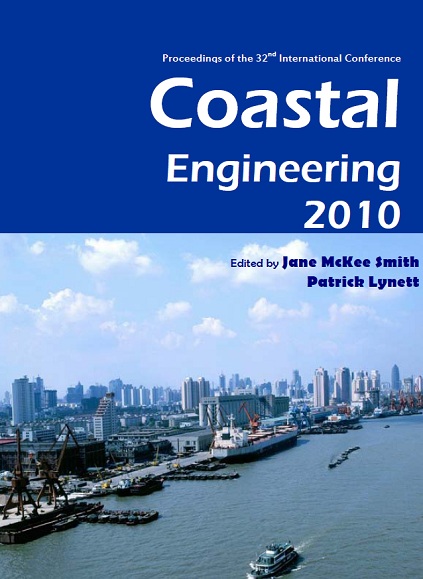Abstract
We analyzed oscillating flow data from U-tube experiments by Lamb et al. (2004) and found that the time-averaged turbulent kinetic energy (TKE) near bed decreased exponentially with height above the bed in high-density-suspension (HDS) flows under waves, and that the ratios of TKE distributions in the streamwise, cross-stream, and vertical dimensions were constant. Based on the finite-mixing-length theory, a semi-theoretical time-averaged suspended sediment concentration model for HDS was developed. To avoid the stability problems with the numerical solution, a simplified model was also formulated through combing the apparent Fickian diffusivity and the damping function. The comparison between the calculated results and measurements shows both models consider the effect of the sediment-induced stratification well.References
Absi, R. 2006. On the effect of sand grain size on turbulent mixing, Proceedings of 30 th International Conference on Coastal Engineering, ASCE, 3019-3029.
Balmforth, N.J., S.G.L. Smith and W.R. Young. 1998. Dynamics of interfaces and layers in a stratified turbulent fluid, Journal of Fluid Mechanics, 355, 329-358. http://dx.doi.org/10.1017/S0022112097007970
Cheng, N.S. 1997. Effect on concentration on settling velocity of sediment particles, Journal of Hydraulic Engineering, 123, 728-731. http://dx.doi.org/10.1061/(ASCE)0733-9429(1997)123:8(728)
Han, H.S. 2005. Vertical profile of suspended fine sediment concentration under breaking waves, Master thesis, Tianjin University (in Chinese).
Hou, Z.Q. and H.Yang. 2004. Analysis of sudden siltation of outer channel of Huanhua Harbor, Journal of Waterway and Harbor, 25, 213-225 (in Chinese).
Lamb, M.P., E. D'Asaro and J.D. Parsons. 2004. Turbulent structure of high-density suspensions formed under waves, Journal of Geophysical Research, 109, C12026. http://dx.doi.org/10.1029/2004JC002355
Lamb, M.P. and J.D. Parsons. 2005. High-density suspension formed under waves, Journal of Sedimentary Research, 75, 386-397. http://dx.doi.org/10.2110/jsr.2005.030
Lewis, W.K., E.R Gilliland. and W.C. Bauer. 1949. Characteristics of fluidized particles, Indusrtial& Engineering Chemistry, 41, 1104-1117. http://dx.doi.org/10.1021/ie50474a004
Nezu, I. and H. Nakagawa. 1993. Turbulence in open channel flows, IAHR Monograph, Balkema, Rotterdam.
Nielsen, P. 1992. Coastal bottom boundary layers and sediment transport, World Scientific Publication, Singapore.
Nielsen, P. and I.A.L. Teakle. 2004. Turbulent diffusion of momentum and suspended particles: A finite-mixinglength theory, Physics of Fluids, 16, 2342-2348. http://dx.doi.org/10.1063/1.1738413
Swart, D.H. 1974. Offshore sediment transport and equilibrium beach profiles, Publication No. 131, Delft Hydraulic Laboratory.
Teakle, I.A.L. 2006. Coastal boundary layer and sediment transport modeling, Ph.D. Dissertation, Queensland University.
Traykovski, P., W.R. Geyer, J.D. Irish, and J.F. Lynch. 2000. The role of wave-induced density-driven fluid mud flows for cross-shelf transport on the Eel continental shelf, Continental Shelf Research, 20, 2113-2140.http://dx.doi.org/10.1016/S0278-4343(00)00071-6
van Rijn L.C. 2007. Unified view of sediment transport by currents and waves: suspended transport, Journal of Hydraulic Engineering, 133, 668-689. http://dx.doi.org/10.1061/(ASCE)0733-9429(2007)133:6(668)
Vinzon, S.B. and A.J. Mehta. 1998. Mechanism for formation of lutoclines by waves, Journal of waterway, port, coastal and ocean engineering, 124, 147-170. http://dx.doi.org/10.1061/(ASCE)0733-950X(1998)124:3(147)
Winterwerp, J.C. 2006. Stratification effects by fine suspended sediment at low, medium, and very high concentrations, Journal of Geophysical Research, 111, C05012. http://dx.doi.org/10.1029/2005JC003019
You, Z.J., D.L. Wilkinson. and P. Nielsen. 1991. Velocity distribution of waves and currents in the combined flow, Coastal Engineering, 15, 525-543. http://dx.doi.org/10.1016/0378-3839(91)90026-D
Zhao, Q. 2006. Fine sediment transport in storm event the Huanghua experience. Proceedings of 30 th International Conference on Coastal Engineering, ASCE, 2956-2968.

